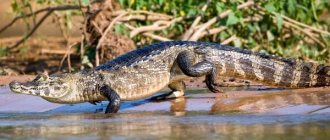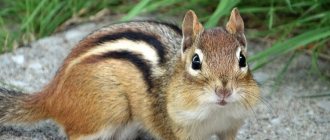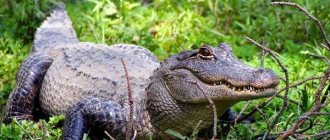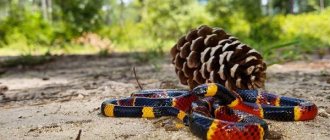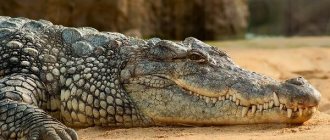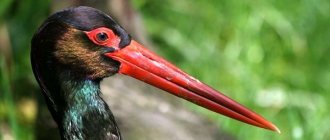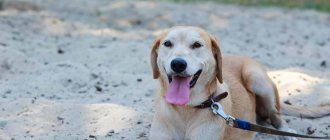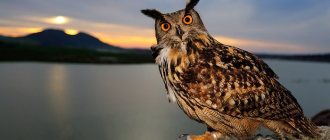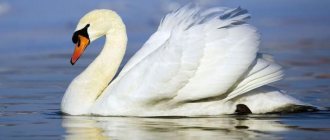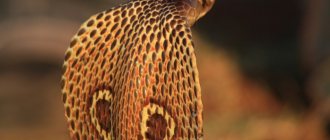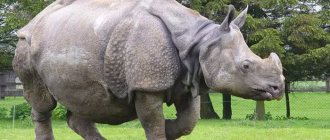Black caimans are descendants of one of the first inhabitants of our planet, who ruled about 150 million years ago.
Today, the black caiman forms a separate species in the alligator family, order of crocodiles. The favorite places of black caimans are quiet ponds and rivers with weak currents, the banks of which are dotted with dense thickets.
Black caiman (Melanosuchus niger).
Description of the species
The animal has scaly, dark-colored skin. It helps to camouflage during night hunts. In the center of the lower jaw there are grayish stripes, which become brown as the caiman matures, and on the sides of the jaw they are white or light yellow. They are clearly visible in young reptiles, but disappear completely by old age.
Like all other varieties of caimans, blacks have a bony crest located in the center of the head between the eyes. In females, you can often see spots under the eyes that are left by blood-sucking parasites. They attack the reptile when it diligently and almost motionlessly guards its nests.
Morphologically, the black caiman is very different from its counterparts. He has a high and narrow skull, large eyes and a small body. The tail of this animal is very flexible. It is usually longer than the body.
Some researchers claim that the animal can use its tail for hunting. The cayman delivers a powerful blow with its tail, causing the victim's flesh to be cut in half.
The number of teeth can vary from 72 to 76. The features of the skull depend on the size, age and sex of the caiman.
Adult males have larger skulls than females of the same age. Scientists suggest that the difference in skull size may influence the taste preferences of males and females.
Genetically, black caimans are close relatives of broad-snouted caimans. Although they are distinguished by larger eyes, a long tail, a massive head, a dorsal crest and a tapered body.
The black caiman is one of the largest reptiles of the current fauna. It is almost as big as the Mississippi alligator (the largest species). Black caimans are also considered the largest predators in the Amazon basin.
This species has been little studied. Scientists find it difficult to indicate the exact dimensions of animals; they can only give approximate ones.
Studies that were conducted in the Central Amazon showed that these animals are growing at about the same rate as Mississippi alligators in South Carolina and Louisiana.
Male black caimans grow slightly slower than the male alligators reported in the study results. The growth rate of females is also lower than that of Mississippi alligators.
Scientists estimate that females living in the Central Amazon begin to prepare a nest when they reach a size of 2.5 meters and are 20 years old.
But due to the small sample, this statement is called into question. Some experts believe that sexual maturity in these animals occurs at 15 years of age and when they reach a size of 2 m.
If we talk about size, the largest representatives of the species caught by hunters were more than 4 meters long, and their age was at least 28 years. Experts from Guiana determined that males stop growing when they reach a length of approximately 3.8 m, and females - 2.9 m.
More than half of the animals killed on the Madeira River were larger than 4 meters. But this can be explained by the fact that hunters specifically chose the largest individuals, since they were the most dangerous to people.
Among the black caiman skulls found, the largest measured 58.8 cm. Scientists estimate that it belonged to an animal whose length was at least 4.8 m.
For comparison, we can cite the length of the skull of the largest Mississippi alligator - 64 cm. This species has a larger head, but its body length was about 4.5 m.
Black caimans weigh slightly less than other crocodiles of the same length. One day, hunters caught an animal 3.35 m, and its mass was only 98 kg.
What does a caiman eat?
Photo: Caiman alligator
Caimans, unlike their larger predatory relatives, are not adapted to eat large animals. This fact is due to the structure of the jaw, the small size of the body, as well as the initial timidity of these reptiles.
Living mainly in wetlands, caimans can profit from the following animals:
- aquatic invertebrates and vertebrates;
- amphibians;
- small reptiles;
- small mammals.
The diet of young animals is dominated by insects that land on water. As they grow, they switch to feeding on larger prey - crustaceans, mollusks, river fish, frogs, small rodents. Adults are able to feed themselves with a small capybara, a dangerous anaconda, and a turtle.
Caimans swallow their prey whole without biting it into pieces. The exception is turtles with their thick shells. For broad-nosed and Paraguayan caimans, aquatic snails are a particularly tasty treat. Due to this preference in nutrition, these reptiles are considered the orderlies of reservoirs, as they regulate the number of these mollusks.
Another name for the Paraguayan caiman is piranha, because it eats these predatory fish, thereby regulating their population. Cases of cannibalism also occur among caimans.
Spreading
Now these reptiles can be found in the following countries:
- Guyana;
- Peru;
- Bolivia;
- Brazil;
- Ecuador;
- Colombia.
It is also believed that the black caiman can be found in Venezuela. Previously, this animal was more widespread.
These representatives of reptiles mainly live in the Amazon River basin. To live, they choose places with weak currents, marshy areas and lakes.
During floods, they can be found in flooded savannas and forests. During drought, animals return to their usual places. To live, reptiles choose inaccessible terrain, avoiding open spaces where they can become prey for hunters.
Where does the caiman live?
Photo: Caiman animal
The habitat of these reptiles is quite wide and depends on the thermal preferences of the caiman species. The distribution area of the crocodile caiman is tropical and subtropical waters of South and Central America. It is found from Guatemala and Mexico to Peru and Brazil. One of its subspecies (fuscus) was relocated to the territory of certain American states bordering the Caribbean Sea (Cuba, Puerto Rico).
The crocodile caiman prefers bodies of water with stagnant fresh water, near small rivers and lakes, as well as wet lowlands. It can not live long in salt water, no more than two days.
The broad-faced caiman is more resistant to low temperatures, therefore it is found along the Atlantic coastline in the waters of Brazil, Paraguay, Bolivia, and northern Argentina. Its favorite habitat is wetlands and small river inlets with fresh, sometimes slightly salty water. It can also settle in ponds near people’s homes.
The Paraguayan caiman prefers to live in areas with a warm climate. It lives in the south of Brazil and Bolivia, in the north of Argentina, Paraguay in swampy lowlands. It can often be seen among floating plant islands.
Nutritional Features
Many people think that all species of crocodiles are predators. But studies of stomach enzymes have shown that caimans are able to digest plant proteins quite well. It is assumed that these animals may be omnivores.
Scientists know practically nothing about what an adult black caiman eats. Most studies were carried out on young animals, since it is quite difficult to interact with adults.
The diet of a reptile up to 2 m long includes:
- fish;
- crustaceans;
- insects;
- various vegetation.
Moreover, it became clear that vegetation significantly predominates in the caiman’s menu.
In the Peruvian Amazon, in Mann National Park, 15 different types of food were found in the stomach of one of the caimans. But mostly they were snails and other invertebrates.
Research conducted in the Brazilian Amazon has proven that the black caiman has feeding behavior similar to that of the crocodile species.
Caimans are able to move quickly on land and grab prey with a sharp movement of the head, dive under water and find food at the bottom, and hunt mammals that come to drink.
But when the ambient air temperature drops, their activity decreases sharply.
Adults are capable of eating large prey. Their diet can include a wide variety of animals of different sizes. It depends on the area in which the reptile lives.
As already mentioned, the diet of adult caimans has been practically unknown. They are believed to feed on the following animals:
- waterfowl;
- capybaras;
- monkey;
- anacondas;
- bakers;
- catfish;
- piranhas
Among the caimans living in Mann National Park (located in the Peruvian Amazon), fish predominates on the menu.
They also feed on mammals, various birds and frogs. Strong and powerful jaws allow these animals to crush the shells of large freshwater turtles.
The stomach contents of an adult caiman were once found to contain the remains of two species of freshwater turtles and a long-tailed otter.
Larger individuals are considered top predators in their habitat. They can kill and eat almost any animal. There are cases when black caimans hunt, then attack and eat crocodiles.
The scars on the bodies of Amazonian dolphins may indicate that they too can be attacked by these predators.
The black variety of caimans hunts giant otters and Amazonian manatees. They also sometimes attack domestic animals, such as dogs, cattle or horses.
In 2022, a study was conducted on the menu of black caimans in Agami Pond. There were no monkeys, capybaras or anacondas nearby, which are the preferred prey for these predators in other environments. When the water level in the reservoir dropped, it was easier for crocodiles to catch fish.
At this time, adult caimans also lived in the pond, and when the water level rose, they immediately left the pond.
These predators could only be found in a flooded forest, where they searched for prey among water birds. Based on this information, scientists decided that seasonality of conditions plays a primary role in eating behavior.
Influence of other predators
Various predators, as well as fish, anacondas and other amphibians can feast on baby crocodiles. But when they grow and reach about one meter in length, the number of enemies they have decreases significantly. Huge otters sometimes kill caimans, although they themselves constantly become their victims. And a predator like a jaguar can pose a threat only to young crocodiles. He is usually afraid of adults. Although there was one case recorded when a large black caiman was caught by this wild animal on land. In general, such amphibians, given their size and enormous strength, have practically no enemies except humans.
Reproduction
The female begins to build her nest at the end of the dry season. To do this, she rakes up grass, branches, leaves and soil on the shore. On average, the diameter of the nest is 1.5 m, and its height reaches 0.75 m.
Typically the female lays 30 to 60 eggs. After this, she carefully hides her eggs in the nest, where they remain for 1.5 months. After 2 months, the cubs are born.
Hatched caimans require a lot of moisture to develop well. It is at this point that the rainy season begins.
During the entire incubation period, the female protects her clutch. After hatching, she helps her babies get out of the soft shell.
Then the mother takes one cub into her mouth and carries them to a shallower body of water. Most often, several broods live in such reservoirs under the supervision of their mothers.
Eggs are laid not every year, but once every 2.3 years. Females take care of their offspring for several months.
But they do not look very carefully, which is why most of the brood dies from predators. Only 20% of babies will survive to adulthood.
Links[edit]
- ^ a b Ross JP (2000). " Melanosuchus niger
".
IUCN Red List of Threatened Species
.
2000
: e.T13053A3407604. DOI: 10.2305/IUCN.UK.2000.RLTS.T13053A3407604.en. - Jump up
↑ Boulenger GA (1889).
Catalog of Chelonians, Rhynchocephalians and Crocodiles in the British Museum (Natural History).
New edition .
London: Trustees of the British Museum (Natural History). (Taylor and Francis, printers). x + 311 s. + Tables I-III. ( Caiman niger
, pp. 292–293). - " Melanosuchus niger
". Reptile Database. www.reptile-database.org. - ↑
Black caiman (Melanosuchus niger). A group of crocodile specialists. Retrieved April 13, 2013. - ^ abc Melanosuchus niger Black caiman. Animal Diversity Network. Retrieved April 13, 2013.
- "Closing the Archive". Archived from the original on 2017-09-06. Retrieved March 9, 2022.
- ^ab Black Caiman, Black Caiman Skull. Dinosaurcorporation.com. Retrieved August 23, 2012.
- ^ abcdefghij Species of crocodiles - Black caiman (Melanosuchus niger). Crocodilian.com. Retrieved August 23, 2012.
- ^ ab Sideleau B, Britton ARC (2012). "Preliminary analysis of crocodile attacks worldwide." pp. 111–114. In
:
Crocodiles
. Proceedings of the 21st Crocodile Specialist Group Workshop, Manila, Philippines. IUCN. Gland, Switzerland, Manila, Philippines. - Foth, K., Bona, P., & Desoh, J. B. (2015). Intraspecific variation in the skull morphology of the black caiman Melanosuchus niger (Alligatoridae, Caimaninae)
. Acta Zoologica, 96(1), 1-13. - ^ a b Da Silveira, Ronis; Ramalho, Emiliano E.; Thorbjarnarson, John B.; Magnusson, William E. (2010). "Predation of caimans by jaguars and the importance of reptiles in the diet of jaguars." Journal of Herpetology
.
44
(3):418–424. DOI: 10.1670/08-340.1. S2CID 86825708. - ^ B s d e e Thorbjarnarson JB (2010). "Black caiman Melanosuchus niger". pp. 29–39. In
:
Manolis SC, Stevenson C (eds). Crocodiles.
Status Review and Conservation Action Plan . Third edition. Darwin: Crocodile Specialist Group. iucncsg.org - French Guiana. kwata.net (2003).
- ^ a b Da Silveira, R., Do Amaral, J. V., Mangusson, W. E. and Thorbjarnarson, J. B. (2011). Melanosuchus niger: signaling behavior and long-distance movement
. Herpetological Review, 42(3): 424-425. - Sirder, H. (2014). Le Caiman noir, Espèce transamazonienne
. Live design of the Guyana Regional Nature Park and personnel under the OYAN program, Cape Orange National Park. - ^ a b Haddad W. Jr., Fonseca W. C. (2011). "Deadly attack on baby black caiman (Melanosuchus niger)". Wildlife and Environmental Medicine
.
22
(1): 62–64. DOI: 10.1016/j.wem.2010.11.010. PMID 21377122. - Cardoso AM, De Souza AJ, Menezes RC, Pereira WL, Tortelly R (2013). "Gastric lesions in free-ranging black caimans ( Melanosuchus niger
) associated with
Brevimulticaecum
."
Veterinary pathology
.
50
(4):582–4. DOI: 10.1177/0300985812459337. PMID 22961885. S2CID 206510179. - Johnson, K., Anderson, S., Dallimore, J., Winser, S., & Warrell, D. A. (2008). The Oxford Handbook of Expedition and Wildlife Medicine
. OUP Oxford. - Da Silveira, R. Magnusson, W. E., & Campos, Z. (1997). Monitoring the distribution, abundance and breeding areas of Caiman crocodilus crocodilus and Melanosuchus niger in the Anavilhanas Archipelago, Central Amazonia, Brazil
. Journal of Herpetology, 514-520. - Barker, G. M. (ed.). (2004). Natural enemies of terrestrial mollusks
. CABI. - Jump up
↑ Junk, W. J., & da Silva, V. M. F. (1997).
Mammals, reptiles and amphibians
. In the Central Amazon Floodplain (pp. 409-417). Springer, Berlin, Heidelberg. - Horna JV, Cintra R, Ruesta PV (2001). "Foraging ecology of the black caiman Melanosuchus niger
in the forests of Western Amazonia: effects of ontogeny and seasonality on diet composition."
Ecotropica
.
7
: 1–11. - Horna V, Zimmerman R, Cintra R, Vasquez R, Horna J (2003). "Foraging ecology of the black caiman ( Melanosuchus niger
) in Manu National Park, Peru."
Lenya
.
4
: 65–72. - Marioni V, Da Silveira R, Magnusson We, Thorbjarnarson J (2008). "Foraging behavior of two sympatric caiman species, Melanosuchus niger
and
Caiman crocodilus
, in the Brazilian Amazon."
Journal of Herpetology
.
42
(4):768–772. DOI: 10.1670/07-306R1.1. S2CID 55729396. - Jump up
↑ Reynolds N (2008).
Dietary competition between black caiman
(Melanosuchus niger)
and spectacled caiman
(Caiman crocodilus)
in Lago Preto Nature Reserve, Peru
. DI512 Dissertation. - Wright, L. (1982). IUCN Red Data Book of Amphibians and Reptiles (Volume 1)
. IUCN. - Hunter, Luke (2011) Predators of the World
. Princeton University Press, ISBN 9780691152288 - The black caiman is an AC tropical fish.
- ↑
Black caiman. Adaptation of Eden. Retrieved September 25, 2015. - Potts, Ryan J. "The World's Endangered Reptiles and Amphibians—II. Black Caiman, Melanosuchus niger." Vermont Herpetology.
- Foth S, Bona R, Desoh JB (2015). "Intraspecific variation in the skull morphology of the black caiman Melanosuchus niger
(Alligatoridae, Caimaninae)".
Acta Zoologica
.
96
(1): 1–13. DOI: 10.1111/azo.12045. - ↑
de la Ossa J, Vogt RC, Ferrara CR (2010).
"Melanosuchus niger (Crocodylia: Alligatoridae) as an opportunistic consumer of turtles in natural habitats". Revista Colombiana de Ciencia Animal
.
2
(2): 244–252. DOI: 10.24188/recia.v2.n2.2010.268. - Jump up ↑
Martin AR, Da Silva VM (2006).
"Sexual dimorphism and body scarring in the boto (Amazon river dolphin) Inia geoffrensis
."
The Science of Marine Mammals
.
22
(1): 25–33. DOI: 10.1111/j.1748-7692.2006.00003.x. - Somaweera, R., O'Brien, M., & Shoe, R. (2013). The role of predators in shaping the natural history of crocodiles
. Herpetological Monographs, 27 (1), 23-51. - Chineri, M. (2000). Predators and prey
. Cherrytree Books. - Jornal Hoje - Bióloga atacada por jacaré na Amazônia luta pela preservação da espécie . G1.globo.com (08/04/2010). Retrieved January 11, 2013. (in Portuguese).
- Welcome to the official website of Mark O'Shea. Markoshea.tv. Retrieved August 23, 2012.
- ↑
TV2 Nord (September 12, 2013). Sjældne kaimanunger kan nu ses af publikum . Retrieved April 23, 2022. (In Danish).
Lifestyle
Black caimans prefer to lead a solitary lifestyle. They can rarely be found in the company of their relatives. The exception is the dry period, when many individuals gather in the remaining isolated bodies of water.
Compared to other species of crocodiles, black caimans very rarely fight for territory. In the wild, it is almost never possible to find a crocodile of this species with missing parts of the tail, scars on the head or damaged limbs.
This often happens in other species, especially if they are kept in zoos or farms. In captivity, black caimans also usually do not fight for territory.
Taxonomy[edit]
Black caiman ( Melanosuchus niger
)
Cuvier's dwarf caiman ( Paleosuchus palpebrosus
)
Smooth-faced caiman ( Paleosuchus trigonatus
)
- Subfamily Caimaninae
Genus †
Acresuchus - Genus † Bottosaurus
[5] - Genus † Centenariosuchus
- Genus † Chinatichampsus
- Genus † Protocaiman
- Genus † Kuttanacaiman
- Genus † Gnatusuchus
- Genus † Culebrasuchus
- Genus † Eocaiman
- Genus † Globidentosuchus
- Genus Paleosuchus P. palpebrosus
, Cuvier's dwarf caiman - P. trigonatus
, smooth-fronted caiman
- C. yacare
, yacare caiman
, spectacled caiman
C. c.
crocodile , spectacled caiman
apaporiensis , Rio Apaporis caiman
fuscus , brown caiman
, broad-nosed caiman
- † M. fisheri
, black caiman
Relationships with a person
Human activities directly affect the caiman population. They are hunted for their unique skin. On the black market this product is very expensive.
But caimans themselves can hunt people. Attacks by these animals have been recorded many times. But still this happens less often than with other species of representatives of the crocodile order.
Although the relative number of attacks that resulted in human death is slightly higher than that of Mississippi alligators.
Species protection
The high commercial value of these animals led to their mass shooting. By the end of the 50s of the last century, the population of black caimans was practically zero.
They could only be found in the most remote places of the Amazon. The caimans were not completely destroyed only because of the inaccessibility of their habitats.
The problem was realized only towards the end of the 70s, when there were a lot of piranhas in the rivers, and capybaras multiplied so much that they destroyed almost all the vegetation. After this, people realized that black caimans were a very important component in the ecological system.
This led to laws prohibiting the extermination of these animals. Now their population (according to approximate estimates) is about 1 million individuals. Population growth has had a beneficial effect on the natural conditions of the continent.
Currently, the black caiman is not in danger of extinction. But they are still listed in the Red Book.
Phylogeny[edit]
Below is a modified cladogram from Brochu (2011). [6]
| Alligatoridae | |
| Caymanians | |
| † Tsoabichi greenriverensis | |
| Paleosuchus trigonatus | |
| † Orthogenysuchus olseni | |
| † Purussaurus neivensis | |
| Cayman Yacare | |
| UCMP 39978 (referred to Caiman lutescens ) | |
| Melanosuchus niger | |
Below is a cladogram modified from Hastings et al.
(2013). [7]
| † Brachychampsa sealeyi | |
| Caymanians | |
| Paleosuchus trigonatus | |
| † Orthogenysuchus olseni | |
| Cayman Yacare | |
| † Caiman lutescens | |
| Melanosuchus niger | |
Interesting Facts
- The black caiman is the largest species in the alligator family. Some scientists claim that in nature there may be individuals whose length reaches 6 m.
- All types of caimans are among the most vocal crocodiles. The black voice strongly resembles the sound of thunder. Used to communicate with other crocodiles, especially during mating season.
- Matthew Reilly describes black caimans in his best-selling book, The Temple. There they constantly eat people who find themselves in the water. The black caiman is also mentioned in “Amazon” by James Rollins. The animal capsized the boat and swallowed the special forces soldier.
The black caiman is a unique animal that affects the ecosystem of almost all of South America. Although the species is not currently in danger, it is necessary to continue to protect it.
If you stop doing this, then due to the value of the skin, the species will again be in danger of extinction in just a couple of decades.
Trophy "Russian Fishing"
In South America, as everyone knows, there is the Amazon River. It is the largest in the world in terms of size. It is adjacent to large bodies of water: Ucayali and Marañon. This pool is home to giant anacondas, piranhas, exotic fish and, of course, crocodiles. The black caiman is also found in the Amazon swamps. Trophy fishing for it is very popular. Since this animal is very rare and beautiful, and its skin is in great demand in markets, people come to this reservoir and hunt for amphibians. Some kill them to sell them to make money. After all, the price of such a catch is very high. And others try to catch predators just to take photos with them and release them back into the river. Because of this treatment of people, the black caiman began to fear them. “Russian fishing” is very popular not only in our area, but also in South America. Many of our compatriots come to the Amazon to hunt crocodiles on their own. For them, it’s like a big sport or a competition among big-catch experts.
To catch this beautiful reptile, you need to take bait from the meat of the animal, attach it to a rope and slightly dip it into a pond. The caiman will smell the scent and swim to the gear. The best time to hunt crocodiles is at night. During this period they are as active as possible and even go to the banks of rivers and lakes. You can also catch small amphibians with fish or large birds.
Also, not far from the reservoirs where crocodiles live, there are special houses for tourists who come to relax and look not only at the wild nature, but also at these amazing individuals. The black caiman is a very large predator that poses a danger not only to small animals, but also to humans.
